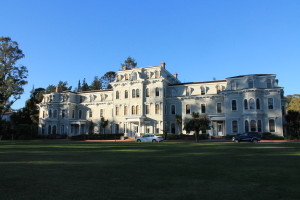While the culture surrounding skateboarding is becoming more prominent in cities like New York City and Los Angeles, the number of Mills students finding their place in this male-centric sport is slowly growing.

Skateboarding can be traced back to the late 1940s, but it didn’t become popular until the 1970s. According to the Huffington Post, skateboarding began as a white suburban activity. Since then, the culture has become more inclusive, and the group of Mills students who skate is getting larger.
Skateboarding was originally tied to surf culture, but began to develop a scene of its own after the 1986 cult classic film “Thrashin’,” which featured famous skateboarder Tony Hawk. Since then, skateboarders have been perceived as rebellious youth, but that stereotype has been challenged in recent years.
Today, big name clothing companies and designers like Urban Outfitters and Yves Saint Laurent feature designs inspired by the culture surrounding skateboarding. Sophomore Katie Funes picked up skateboarding last semester and sometimes feels unwelcome in places like skate shops due to the male-centric nature of the culture.
“As a brown girl, I don’t think it’s ridiculous for me to want to skate,” Funes said. “But I think it’s ridiculous for me not to feel welcome.”
Funes was initially drawn to skating by the fashion that is an integral part of the culture. However, she doesn’t like how trendy the style has become since it originated in communities of color.
“I really like street wear and that style,” Funes said. “A lot of [the culture] has its roots in communities of color and for it to become this thing that white boys do in Venice Beach is kind of grimy.”
Trying to break into such a male-dominated sport can be intimidating, and sophomores Maia Zaiee and Hannah Lu-Way were the targets of sexist comments while skating in Oakland.

“We were at First Friday and these men were like ‘I bet ya’ll can’t ride those,’” Zaiee said. “Why would we be carrying them around if we couldn’t ride it?”
Lu-Way would practice skating at skate parks in Sacramento with her younger brother, and she often found that she was the only woman there.
“Most of the time, I was the only female there,” Lu-Way said. “It was cool though; no one really bothered me. They were all just doing their own thing.”
Although there are a handful of people that do skate at Mills, sophomore Andrea Ortiz-Galdámez, who has been skating for two years, doesn’t think there is a strong skate culture on campus yet.

“I don’t think there is a skate culture here,”Ortiz-Galdámez said. “I think that would be cool if there were, though.”
Ortiz-Galdámez credits the lack of a skate culture at Mills to the lack of a skate culture in Oakland and the East Bay Area. Ortiz-Galdámez hopes to find more of a culture at skate parks in Oakland.
Lu-Way and Zaiee agree that there is no prominent skate culture on the Mills campus yet, but feel like they have created a culture of their own. Lu-Way and Zaiee like to goof off and skate around campus after they finish studying at night.
“It’s really cool at night to go skateboarding on campus because it’s really quiet and you can skate in the streets and do whatever,” Lu-Way said. “I feel like that’s where most of our personal culture comes from.”
Zaiee agrees that she and Lu-Way have made their own rules while skating on campus.
“Yeah, that’s kind of our thing,” Zaiee said. “Skating at night and screaming. We just blast music and scream.”
Lu-way and Zaiee hope that the skating culture at Mills will grow and that more students will give skateboarding a try.
“If you’ve got two feet and a board, you can skate,” Lu-Way said. Zaiee added, “and you’ve got to be willing to fall.”


